We welcome everyone to be part of our group, regardless of age, gender identification, cultural background or bushcare experience. Running a ‘Friends group’ requires both on ground and behind-the-scenes volunteers. Do you have a particular interest area or skill you can offer? See our volunteer flyer here for areas we need help with. Please contact us, we would love to hear from you!
‘My Volunteer Story’ Series
In 2023, we are putting the spotlight on our wonderful volunteers! Meet some of our Committee Members and helpers and learn about their volunteering journey.
Jennie – Committee Member
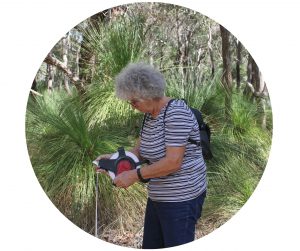
I knew I would have to do something worthwhile with my time when I retired. I love being outdoors, bush walking and photography, which was a perfect fit with the volunteer work I now do at Koondoola and Trigg Bushland.
My volunteering journey started after I did a GOLD (Growing Old Living Dangerously} planting event with the City of Wanneroo. I live close to Koondoola Bushland and asked the City’s Conservation Officer if there was anything I could do there. The answer was YES.
I started by learning what plants grows in Banksia woodland. Trying to find all the info in one place was impossible so I made my own wildflower book. Once I could tell the difference between a native plant and a weed I started weeding. While weeding I also remove rubbish and generally monitor what’s happening in the bushland and general maintenance that’s required.
As I increased my knowledge, I started leading the annual Community Guided Walk in Koondoola Bushland with the Conservation Officer as well as walks for migrant groups and the local primary school which are great fun. I also help with community and school planting days, fauna surveys and monitoring wildlife cameras. As I still needed a better understanding of our flora trained to be a Kings Park Guide which was not something I had ever considered being able to undertake.
A few years ago, I met the Chairperson of Friends of Trigg Bushland, Mitch Polain, who obviously thought I had too much free time and needed to learn more about coastal plants! I joined the Friends of Trigg bushland Management Committee last year. It is interesting to see how a well-established Friends group is run and to learn new skills like ground water level monitoring (see picture).
I have gained so much from volunteering. An excuse to spend more time in the bush. A better understanding of just how valuable our bushland is. The opportunity to learn from truly knowledgeable people and be constantly amazed by their generosity in sharing a lifetime of learning. I have used my brain more in the time I retired than I had for years, including how to do a presentation – I had never used PowerPoint or spoken publicly before. I now know how to post events on Eventbrite and use Facebook.
I think volunteering has improved my self-confidence and my physical and mental health. There is a very social side to volunteering – I have made a completely different group of friends who I would never have normally met. We are diverse but share a love of nature.
I recommend to anyone to give volunteering with Friends of Trigg Bushland a try, it can be the beginning of a whole new phase of your life. You will be welcomed for any skills you can offer, whether it is the physical side of bush care, organising events, publicity, record keeping and more.
When I’m not in the bush you’ll find me in the kitchen baking and trying to find the world’s best brownie recipe, engrossed in a good book, at exercise classes and drinking a good red wine.
Bushland Restoration
Weeding takes place the first Sunday of most months. Winter hours are from 9 am to 11 am (usually beginning in May) and summer hours are from 8 am until 10 am (usually beginning around October). See photos from weeding 1 May here and 4 December here.
Weeding locations may change due to weed growth, community involvement and to dovetail with the City of Stirling weeding strategy. Please check the Upcoming Events page, or email us to confirm the location for weeding: triggbushland@gmail.com
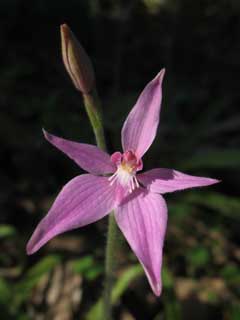
Caladenia latifolia
One of the most important ways to preserve the bush is to regularly rid it of invasive weeds, particularly in urban reserves such as Trigg Bushland, which are under constant attack from weeds in adjoining blocks as well as from street drainage – which unfortunately diverts into the bushland during rainstorms.
Weeds are plants that grow in a place they are not wanted, or a place where they do not naturally occur. Most weeds have been spread directly or indirectly by human beings.
Instruction and advice are given to new participants. Weed collection bags are supplied by the City of Stirling and morning tea is BYO.
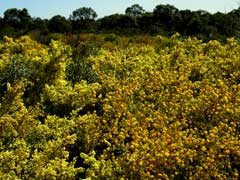
Lemon yellow A. truncata on left, Gold yellow A. pulchella on right
It is meant to be a relaxing and enjoyable morning, with the added benefits that you are likely to see many interesting plants and insects, and that you are doing something of great benefit to the bush.
WEED MANAGEMENT
Hand-pull
• Hand-pulling is a relatively gentle control method for seedlings, herbs and grasses.
• Lupin and Euphorbia can be easily hand-weeded from the bush, particularly young plants that have not developed an extensive root system.
• Hand-pulling is best carried out when the soil is damp, when the root systems are more easily dislodged and less damage is done to the soil structure. Pelargonium should only be hand-pulled when the soil is soft as the roots will snap off the main stalk, and re-sprout the following year.
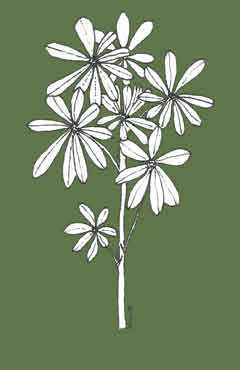
Trigg bushland weed Lupinus cosentiii drawing N McLaren
• Remove any seeds of fruit that are present and bag these for disposal, so that new plants will not grow from the seeds.
• Take hold of the plant firmly near ground level and pull. Avoid grabbing the plant too high as it is likely to break and remaining plant material may re-shoot.
• After removing the plant, tamp the disturbed soil down so that seeds from other weeds will not sprout.
• Bag all weeds and carry to the nearest path, for later collection by the City of Stirling.
Dig-out
• Dig out plants with tougher root systems, such as Pelargonium.
• Insert a trowel or fork into the soil outside the root system. Gently loosen the soil, work around the roots and then work the plant and roots out gently.
• Take great care to ensure all Pelargonium roots come out, otherwise they we will re-sprout the following year.
• Bag all weeds and carry to the nearest path, for later collection by the City of Stirling.
How to work
• It is important to minimise any disturbance to the ground. Do not scuff or kick the ground.
• Take care where you walk, and try not to harm native plants.
• Work slowly and methodically. Pace yourself. Relax and enjoy being in the bush!
Safety
• Wear long pants, long sleeve shirt, hat, stout shoes and gloves at all times.
• Ask a member of Friends of Trigg Bushland if you have any questions or are unsure about anything at all.
• Do not handle any insects, etc that you may observe.
• Drink plenty of water.
Download a copy of our Weed Identification Guide and Weed Management Hints.
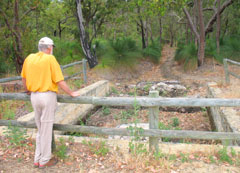
Stormwater drain into Trigg Bushland



Recent Comments